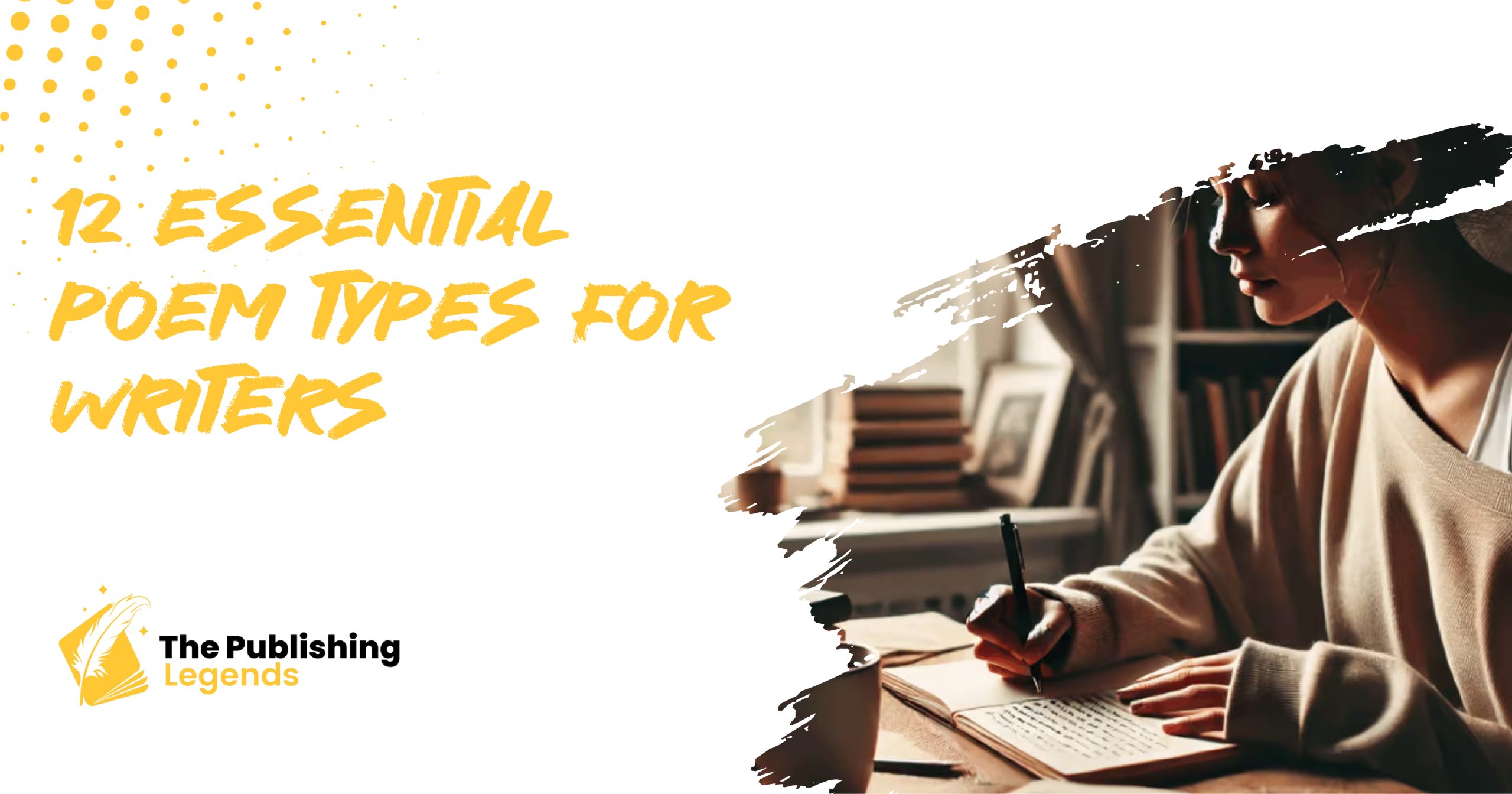Poetry is an ancient and versatile form of expression that allows writers to explore emotions, stories, and ideas in ways that few other writing forms can match. While writing poetry can feel free and spontaneous, the different types of poems offer structured ways to challenge your creativity and convey your message more effectively. Whether you’re a beginner poet or an experienced writer, understanding various poetic forms can help expand your toolkit and inspire fresh perspectives.
In this blog, we will explore 12 essential poem types every writer should know. Each form has its own set of rules, rhythms, and unique characteristics, offering distinct ways to communicate ideas. We’ll go over what makes each form special, tips for writing in that style, and examples to help you visualize how each can be used.
1. Haiku: The Power of Simplicity
The Haiku is a Japanese poetic form known for its brevity and simplicity. It consists of just three lines with a 5-7-5 syllable structure. Haikus are traditionally focused on nature, capturing moments of stillness and beauty in just a few words. The challenge of writing a Haiku lies in creating a profound image or emotion within its limited structure.
For instance, a Haiku might describe a fleeting moment, such as the feeling of morning dew or the sound of wind rustling through the trees. The simplicity of the Haiku form encourages careful word choice and a deep focus on imagery.
Example Haiku:
Autumn leaves falling,
Whispers of a cold wind call,
Silence fills the air.
When writing your own Haiku, aim to evoke a clear image or emotion, using sensory details and avoiding unnecessary words.
Improve Your Writing with Expert Guidance
Explore our editing services can help you refine your poetry, understand structure, and enhance your creative voice.
2. Sonnet: The Classic Fourteen Lines
The Sonnet is one of the most well-known and enduring forms in poetry. A Sonnet consists of 14 lines, usually written in iambic pentameter, a rhythmic pattern of 10 syllables per line. There are two primary types of Sonnets: the Shakespearean (English) Sonnet and the Petrarchan (Italian) Sonnet.
The Shakespearean Sonnet follows the ABAB CDCD EFEF GG rhyme scheme, ending with a couplet that often provides a resolution or twist. Petrarchan Sonnets, on the other hand, follow an ABBA ABBA pattern for the first eight lines and have a CDE CDE rhyme scheme for the remaining six.
Sonnets have been historically used to explore complex themes, especially love, beauty, and time. The form allows poets to develop an idea in the first eight lines (the octave) and then provide a resolution or deeper insight in the final six lines (the sestet).
Example Sonnet:
Shall I compare thee to a summer’s day?
Thou art more lovely and more temperate:
Rough winds do shake the darling buds of May,
And summer’s lease hath all too short a date.
(Shakespeare, Sonnet 18)
3. Limerick: The Humorous and Rhythmic Poem
Limericks are fun, often humorous poems made up of five lines. They follow an AABBA rhyme scheme, with the first, second, and fifth lines having three feet (or stressed syllables), and the third and fourth lines having two feet.
Limericks are known for their playful and sometimes silly tone, making them a great way to explore light-hearted topics. The rhythm and rhyme of a Limerick give it a musical quality, making it easy to read and fun to write.
Example Limerick:
There once was a cat from Peru,
Who dreamt of eating a shoe.
He tried it one day,
But it turned out to weigh,
And now he just eats a nice stew.
When writing your own Limericks, aim for humor or absurdity, and make sure the rhyme flows smoothly.
4. Villanelle: The Repetitive and Haunting Form
The Villanelle is a 19-line poem with a unique repetitive structure. It consists of five tercets (three-line stanzas) followed by a quatrain (four-line stanza). The most distinctive feature of a Villanelle is its two refrains: the first and third lines of the poem are repeated alternately throughout the poem.
Villanelles often evoke strong emotions due to their repetitive nature, which mirrors obsession or cyclical themes. The repetition of lines creates a sense of urgency and rhythm, pulling the reader back to the same thoughts over and over.
Example Villanelle:
Do not go gentle into that good night,
Old age should burn and rave at close of day;
Rage, rage against the dying of the light.
(“Do Not Go Gentle Into That Good Night” by Dylan Thomas)
Writing a Villanelle requires careful attention to repetition and rhyme, so choosing your refrains thoughtfully is crucial.
5. Free Verse: Freedom in Structure
Free Verse is the ultimate form of poetic freedom. Unlike other forms, it does not adhere to any specific rhyme scheme or meter. Free Verse poems focus on natural rhythms and allow poets to write without the constraints of structure.
Free Verse offers limitless creative possibilities, allowing you to experiment with pacing, line length, and language. While there are no set rules, the key to writing in Free Verse is ensuring that the poem flows naturally, maintaining a sense of rhythm even if it’s not formally structured.
Example Free Verse:
The world is a dream,
Endlessly moving,
Shifting like shadows at dusk.
The wind whispers in the trees,
As we hold onto time’s fleeting thread.
Use imagery and clear intentions when writing Free Verse, ensuring that the flow still feels deliberate.
6. Acrostic: A Poem in Every Letter
An Acrostic poem is a type of poem where the first letter of each line spells out a word or message vertically. This form encourages creativity, as the writer must find ways to express their theme while keeping the letters in mind. Acrostic poems are often used for names, themes, or short phrases.
Example Acrostic:
Soft winds whisper through the trees,
Echoing the song of the sea.
As stars above twinkle and gleam,
Silence blankets the world, a dream.
Acrostic poems encourage creativity and can be a fun exercise for writers looking to challenge themselves.
7. Ballad: Storytelling Through Song
A Ballad is a narrative poem that tells a story, often set to music. Traditionally, Ballads have a simple structure and rhyme scheme (ABAB or ABCB), and they focus on themes like love, heroism, tragedy, or adventure. Ballads are often written in a straightforward manner, making them accessible to a wide audience.
The simplicity of the Ballad’s form helps to emphasize its storytelling, allowing poets to tell captivating, emotional tales.
Example Ballad:
The wind cried out in sorrow,
As the night began to fall.
A soldier rode into battle,
And he heard the trumpets call.
Ballads are great for writers who want to tell a story with emotion and rhythm, making them an ideal format for those interested in narrative poetry.
8. Ode: A Poem of Praise
The Ode is a formal, often lyrical poem that praises or glorifies a person, object, or abstract concept. Odes can vary in structure but are typically written in a dignified, elevated tone. They were often used in ancient Greece and Rome to honor gods, heroes, and great achievements, but modern Odes can praise anything that inspires admiration.
Example Ode:
Ode to the Nightingale
Thou who singest in the dark,
Harmonious notes that pierce the air,
And spread the joy of life so fair.
When writing an Ode, ensure that the tone remains high and reverential, celebrating the subject with passion and respect.
9. Concrete Poem: Poetry that Takes Shape
A Concrete poem, also known as a visual poem, is one where the poem’s layout and shape mirror the subject matter. For instance, a poem about a tree might be written in the shape of a tree. The visual aspect brings another meaning to the poem and so it becomes an exclusive combination of art and poetry.
Example Concrete Poem:
(Imagine the poem about a tree with the words arranged in the shape of a tree)
Concrete poems allow for experimentation with how the physical structure of the poem can complement its theme, encouraging a deeper connection between the reader and the visual representation.
10. Epigram: A Witty and Thoughtful Statement
Epigrams are short, witty poems or sayings that express an idea in a clever or concise manner. They are typically written in just one or two lines, often containing a twist or punchline. Epigrams are excellent for making thought-provoking statements or humorous observations.
Example Epigram:
“Brevity is the soul of wit,”
~ William Shakespeare
Epigrams challenge writers to deliver powerful messages with the fewest possible words, making them a perfect form for capturing an insight or epiphany in a condensed manner.
11. Sestina: The Complex Six-Stanza Form
The Sestina is a challenging and intricate form of poetry consisting of six stanzas, each with six lines. The unique feature of the Sestina is its fixed pattern of word repetition; the end words of the first stanza are repeated in a set order throughout the rest of the poem. The structure demands attention to detail and creativity, as the poet must find ways to integrate these repeating words meaningfully.
Example Sestina:
(Sestinas often require deeper study, but their complexity offers rich reward through repetition and wordplay.)
Publish Your Poetry Professionally
Learn about publishing services that assist poets in bringing their work to print or digital platforms with professional formatting and distribution.
12. Tanka: The Extended Haiku
The Tanka is a Japanese poem based on the Haiku pattern; it consists of two lines in addition to the Haiku lines. Tanka poems will generally revolve around nature or feelings, just like Haikus. Tanka form is syllabic (pattern is 5-7-5-7-7).
Example Tanka:
The morning sunlight,
Falls gently on the cool stream,
Shimmering on rocks,
A flower blooms in silence,
Its fragrance fills the still air.
The Tanka provides more space for expression than a Haiku while maintaining simplicity and focus.
Here are the 150-word write-ups for each of the specified headings:
14. The Importance of Structure in Poetry
The importance of structure in poetry is that it defines the rhythm, flow and general effect of a poem. It provides a framework that guides both the writer and the reader, establishing expectations and creating patterns that can be played with for effect. Following a specific form, like a Sonnet or Villanelle, helps maintain discipline in writing, fostering creativity within a set of rules. It also brings clarity, as the repetition and rhythm can emphasize certain themes or emotions.
On the other hand, Free Verse allows more freedom, enabling poets to break away from rigid rules and focus purely on expression. However, without structure, Free Verse can sometimes feel meandering or lack cohesion. A good balance between structure and creative freedom can elevate a poem, using a fixed form for its rhythm, while allowing flexibility in content. This balance ensures both artistry and clarity.
13. How to Choose the Right Poem Type for Your Message
Choosing the right poem type is essential to conveying your message effectively. Each type serves a unique purpose, and selecting the appropriate form can enhance the emotional resonance of your words. For instance, if you’re looking to capture a moment in nature or fleeting emotion, a Haiku’s simplicity is perfect. If you want to explore themes of love or time, a Sonnet’s 14 lines offer the perfect structure for depth and reflection.
A Ballad, with its narrative nature, is ideal for storytelling, while an Ode is fitting for praising or honoring something or someone. Meanwhile, Free Verse allows flexibility, which works well for personal reflection or contemporary themes. Understanding the subject and tone of your poem will help you choose the best type, whether you need a structured, rhythmic piece, or a form that allows more creative freedom.
15. How Poetic Form Affects Modern Poetry
Although traditional poetic forms like the Sonnet, Villanelle, and Haiku may seem old-fashioned, they continue to influence modern poets today. Classic forms bring a sense of structure and discipline that many contemporary poets find liberating, as they provide boundaries within which creativity can flourish. These time-tested forms help poets refine their craft, pushing them to experiment with language, rhyme, and rhythm in innovative ways.
Modern poets often adapt these forms to explore contemporary themes, such as identity, social justice, or the human experience in a digital world. For example, poets may use the Villanelle’s repetition to highlight obsessive thoughts or patterns in modern life. Writers today find that old forms serve as a bridge between tradition and innovation, allowing them to reflect on both timeless and timely issues through an established lens.
16. Final Tips for Aspiring Poets
Aspiring poets should remember that poetry is about expression, so write often to refine your craft. Experiment with different poetic forms to expand your skill set and gain a deeper understanding of how structure impacts meaning. Whether you’re working with rigid forms like the Sonnet or the free-flowing Free Verse, learning the rules gives you the freedom to break them effectively.
Reading widely is just as crucial. By exploring the works of both classic and contemporary poets, you’ll gain insight into how various styles work and develop your unique voice. Don’t shy away from challenging yourself with different forms; each one teaches you something new about language, rhythm, and emotional depth. Lastly, embrace both structure and creativity as you develop your own poetic style. Keep writing, and let your poems evolve naturally.
Conclusion
Understanding the variety of poem types available to writers is essential for expanding your creative boundaries. Each form offers unique opportunities for expression, from the structured elegance of the Sonnet to the playful rhythm of the Limerick. Experimenting with these forms will not only improve your versatility as a writer but also help you discover new ways to convey your message with clarity and style. Whether you’re looking to write a heartfelt Ode, a narrative Ballad, or a visual Concrete poem, mastering these forms will deepen your poetic understanding and spark new ideas for your writing.





